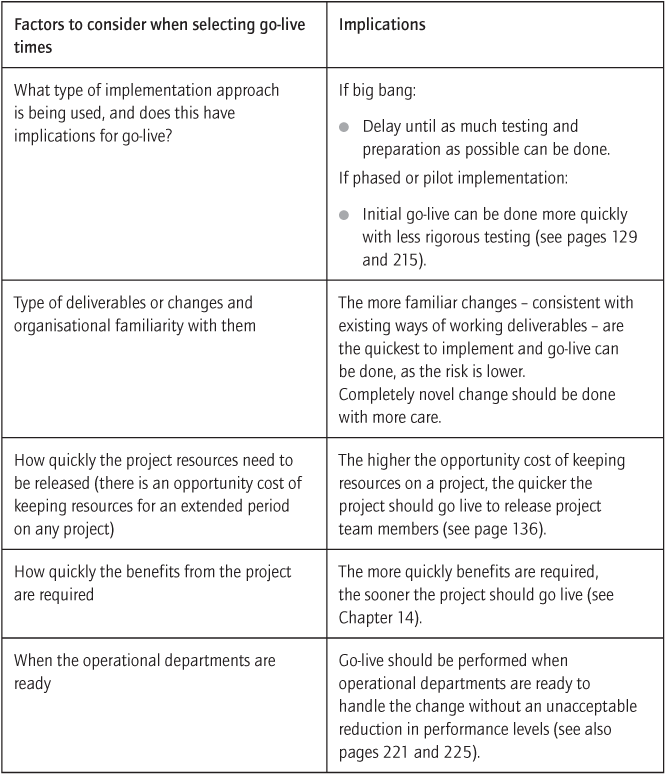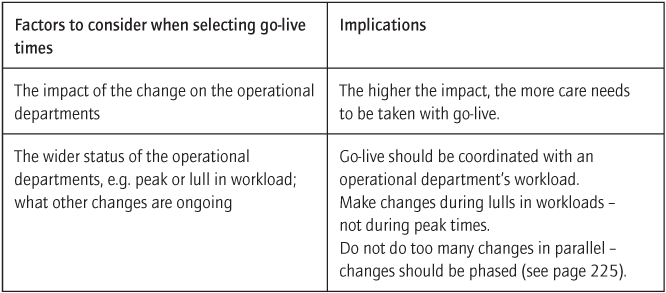This chapter deals with the implementation and handover of project deliverables, and the resulting organisational change.
Introduction
This chapter deals with the implementation and handover of project deliverables, and the resulting organisational change. Creating quality deliverables is not enough; they have to be used. If the deliverables are not used, nothing changes once the project is complete. That means no benefits will be realised.
Change is an inevitable outcome of successful projects, but it should not be left to chance. Change can be managed through change management. Change management is a complex subject and this chapter introduces project managers to the subject.
The term operations is used as shorthand for the parts of the business that project deliverables are implemented in, and which change as a result of this implementation.
Preparing for project handover and operational readiness
Many projects complete by handing over deliverables to operations. Operations must take ongoing responsibility for the maintenance of the deliverables. There is a big difference between simply handing deliverables to operations (often called ‘throwing them over the wall’) and performing an effective handover.
If you want your project to lead to sustained change, a well-managed handover is essential. Key steps in an effective handover are:
- Develop a handover plan. Be willing to adapt this plan to respond to unexpected situations. Handover is complex and should not be a one-line item in the project plan. Handover needs to be broken into its constituent tasks, with responsibility allocated for completing each task.
- Confirm that appropriate levels of testing and verification are completed before moving into handover.
- Check that the deliverables from the project are in an acceptable state, meeting the quality needs of the organisation.
- Resolve any major issues associated with the project or the deliverables.
- Confirm that operational departments are aware and ready for the handover – and ready for the process of changing as the handover occurs.
- Ensure that the operational departments are capable of handling the deliverables.
- Assess what skills or knowledge is required to use the deliverables to their full potential.
- Identify any capability gaps between what is required and the current capability of the organisation.
- Close gaps by appropriate measures, e.g. training and education, recruitment of new staff, defining service-level agreements for support, or putting maintenance contracts in place. This should be completed as a planned part of the project.
- Ensure operations are willing to take responsibility and have the capability to resolve any minor issues that have not been fixed as part of the project.
- Understand the impact on operations during change and adapt performance measures appropriately for the period of change.
- Check that ongoing budgetary ownership is clear, and that there are sufficient funds allocated in the budget to take on responsibility for the deliverables.
Dealing with resistance and support
An aspect of any change is that some people will support it and others will resist it. Reacting to change is natural. If a change is to be sustained, support for the change must be greater than the resistance to it. Effective change management requires reactions to be assessed, and resistance and support dealt with. (Also see page 56.)
- Prepare for dealing with resistance and support, and ensure there is sufficient time and resource in the project plan to handle it.
- Identify a senior sponsor who is willing to drive the change and the need for the change. The sponsor must be willing to spend significant time convincing people of the need for the change.
- Identify which stakeholders are affected by the change. This is usually staff and teams in your organisation. If appropriate, consider groups external to your organisation (e.g. customers and suppliers).
- Determine the impact of the change upon each of the identified individuals and groups.
- Eliminate any stakeholder groups who are really peripheral from further consideration. You cannot manage everyone’s response.
- Predict the response to the change from the remaining stakeholders.
- Determine planned actions to use the support and overcome resistance. Sometimes actions, to make use of support or overcome resistance, require you to adapt your project approach. Do this willingly, as overcoming resistance is a core component of any change project.
- Implement the identified actions.
- Monitor response to actions. Plan and implement subsequent actions. Continue to do this until the change is successful.
Tips for managing resistance and support:
- Accept that managing resistance and support is one of the main activities when dealing with a project that leads to significant change.
- Listen to resistance. Often resistance will be reasonable, and you may get some great ideas and want to change a project as a result of them.
- Don’t assume that a supporter is in favour of every aspect of a change. For example, it is not unusual to find people who agree with the principle of change, but who do not agree with the way the change is being pursued.
- Don’t assume that power and rational argument will overcome all resistance. Forcing people to change will lower their motivation and may make resistance become hidden, which is harder to deal with. Some resistance will be at an emotional level, and rational argument alone will not overcome it.
- When dealing with people’s reactions you cannot fully predict the nature or strength of their response. Therefore, in any situation in which a response is likely you need to be willing to tailor your plan to handle it.
- Try to be open and communicate as much as possible. This is not always practical, but if you can keep your actions in line with your communications you will develop greater trust, which will make your job easier.
- Don’t assume that just because you have said something once that anyone has heard or understood. Key messages need to be repeated many times, often in different ways.
Deciding when to go live
A change is a transition from one way of working to a new way of working. This transition period is known as go-live. Go-live should not happen just because a project ends, but needs to take into account a number of factors. There is usually no perfect time to go live, and a balance has to be found between the factors listed in the following table:
Supporting the organisation during implementation
A key factor in successful change management is the level of support provided to the organisation beyond the immediate project. From the narrow perspective of creating quality deliverables such support is often unnecessary, but to ensure a successful and sustained change, it is usually essential.
Key tips:
- Communications are central to change – without adequate communication, effective change is unlikely.
- Keep everyone informed of what is going on and what is planned.
- Tailor communications to suit different audiences.
- Be willing to communicate key messages repeatedly. It can take several attempts for people to grasp and accept some components of change.
- Make sure senior line managers understand the change, support it, and act in a way that is consistent with it.
- Listen to staff and provide a way for them to raise concerns and make suggestions.
- Deal with all concerns. Even if it is only to say nothing can be done, explain why nothing can be done.
- Be alert to suggestions and worries of staff directly impacted by the change.
- Try to involve people in the change. People are more likely to accept change if they feel involved in it.
- Ensure you are creating and implementing quality deliverables. If the deliverables are not good enough, don’t go ahead with the implementation. Whatever the benefits of quickly finishing the project, there will be a high and long-term price for poor-quality deliverables.
- Keep everyone doing what they are meant to do during the implementation. An organisation cannot stop simply because a change is under way. Normal work has to continue, as far as possible, uninterrupted.
- Expect and plan for a dip in operational performance. Good change management minimises the depth of the dip in performance, and the length of time it goes on for, but it is inevitable. Expectations should be managed regarding anticipated performance declines during change.
- Help people adapt to the change, accepting that different people take different lengths of time to adapt and require different types of support.
- Expect the unexpected! Be ready to resolve unpredicted problems and respond to unexpected outcomes. Build some contingency into your plan to handle this. Implementation is the time when the most unexpected problems occur.
- Keep the project team on board. Thanking people goes a long way towards maintaining motivation. Ensure there are appropriate rewards and celebrations as the change completes – you will soon need the same people for the next project, so it’s worth leaving them with a positive attitude.
Determining when a change is complete and if it is successful
Organisations are never static. They undergo a constant series of changes. It is not always clear when one change finishes and the next starts. Indications that a change is complete and successful are:
- The project that caused the change is complete and resources released.
- The deliverables are signed off and handed over.
- Focus is now on the future and the next change. The project or the problems it created are yesterday’s news.
- The project deliverables are in productive use. Too many projects complete and at the end of them no one does anything differently. If no one in the organisation is doing anything differently – no change has occurred.
- Benefits are being realised.
- The change is sustained and has become the standard way of working. It is no longer regarded as a change.
- The organisation has learnt what it can from the process of changing.
Critical success factors for change
There are many factors which contribute to the success of change. Some of the most important factors that lead to successful changes are:
- The change has a clear direction that is relevant and widely understood.
- There is an accepted need for change and an associated sense of urgency to change.
- There is a consensus that the particular change being pursued is a good way to achieve the outcome desired.
- Active, visible leadership and sponsorship for the change exists at a sufficiently senior level. The behaviour of senior managers and executives is consistent with change.
- HR policies and the performance management system are consistent with the change, and people are rewarded for acting in a way that is in harmony with and reinforces the change.
- There are adequate communications, and staff feel they have been kept informed.
- The project team driving the change, and the change sponsor, listen to the organisation. People perceive they are listened to with understanding and their concerns are dealt with.
- The project team are focused on the change, not simply the creation of deliverables or completing the tasks in the plan. This includes the human dimension as well as the technical dimensions of the project.
- The change is managed in a flexible way. There is a plan, but it is understood that the change won’t happen exactly as planned. There will be unexpected outcomes and they must be managed.
- The organisation feels involved in the change and has the capacity (resources, time and emotional capacity) to deal with the change.
- Project and business impact risk are continually assessed and managed as the change progresses.
Managing multiple changes in parallel
In many organisations a significant challenge is delivering an ongoing series of changes successfully. Factors to consider are:
- Ensuring that the different changes are consistent and complementary, e.g. there is little point in running a project to improve staff morale at the same time as a headcount reduction project.
- Implementing the different changes in the most efficient way. For example, can some changes be combined into a single project without making the project excessively complex or risky?
- The experience of the organisation and the impacted operational departments in handling change. Organisations in which change is common develop expertise in handling changes. Care should be taken in organisations which are unfamiliar with change, and implementing too ambitious a change too quickly should be avoided.
- Variations in the operational departments’ capacity and capability to accept and absorb the change. Human beings can only cope with so much change at any one time. Changes need to be planned from the viewpoint of the departments being changed, taking account of:
- Operational impact of the change. An organisation can normally accept a maximum decline in performance at any one time. Too many changes at once will have an overly detrimental impact on performance.
- Human resources allocated to the change project. Every change project needs people. Do too many projects at once and there will not be enough staff to perform business-as-usual operations.
- The complexity of the change. People take time to understand and learn how to work in a changed way. Perform too many changes at once, and staff will struggle to cope.




